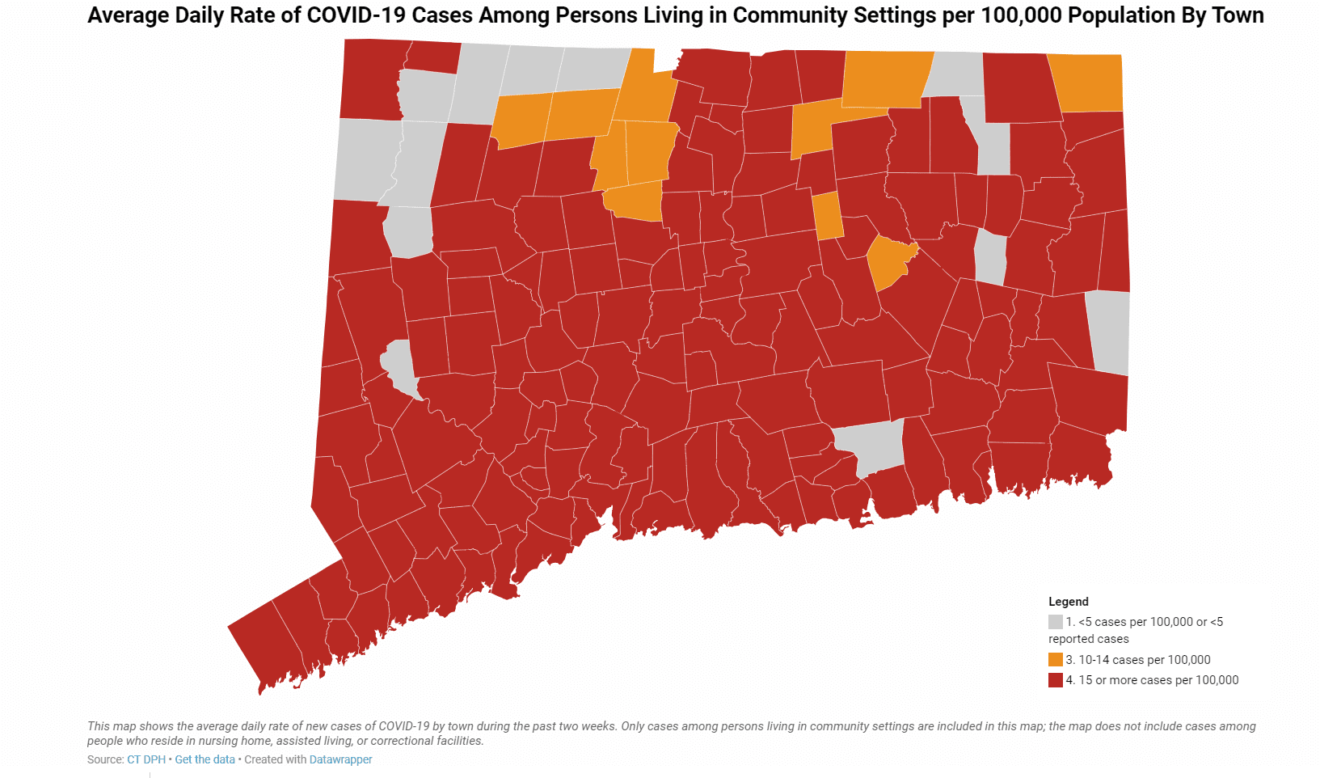The state reported today that 145 of Connecticut’s 169 municipalities have been classified as “high alert” zones, turning Connecticut’s latest COVID map nearly solid red.
Gov. Ned Lamont referred to the numbers as “disturbing.”
He said that Connecticut had conducted 36,000 tests this week and added 60 additional testing sites.
The state reported a 6.5 percent positivity rate, with a seven-day rolling average of 5.8 percent. Hospitalizations and deaths have also increased. Twenty-four more hospitalizations and 21 deaths were reported today.
“A lot of people think, this time around, it’s safer,” said Lamont. “No. Twenty-one fatalities in the last day alone. Pay attention to that.”
According to Lamont, 96 percent of Connecticut residents now live in a high alert zone.
Southeast Connecticut
The single grey spot in the sea of red in Southeast Connecticut is the town of Lyme, which has reported only two positive cases over the last two weeks.
Madison, Guilford, Chester, Old Lyme and East Lyme all moved into the high risk category for the first time this week.

Yet not all of the towns in the red zone have experienced huge spikes in comparison to a week ago. Chester, Deep River, and Essex each experienced a decrease in their case numbers since last week. Old Saybrook’s number of cases has remained roughly equal: 15 last week and 17 this week.
In contrast, Old Lyme’s cases more than doubled, from six to 13. Cases in East Haddam went from four to 33, and New London, Waterford and East Lyme all reported about 20 more cases this week in comparison to last week.
Statewide conformity, regional disparities
Lamont cited the map as proof that statewide cooperation is more effective than imposing restrictions town-by-town.
By the same token, Lamont said, the surrounding states needed to continue to coordinate their restrictions. Earlier this week, Lamont and neighboring states drafted a series of guidelines for university students, saying that students have to test negative before leaving campus and advising students to quarantine before going home. The governor also placed a moratorium on all high school sports, citing cellular data that traced 29 outbreaks back to sports events.
However, Lamont has so far refused to consider imposing tighter restrictions even as neighboring states are doing so. Rhode Island Gov. Gina Raimondo announced today that the state would enter a “two-week pause” beginning on November 30. Bars and gyms will be closed, all colleges will shift to remote learning and new restrictions will apply to restaurants, stores and high schools.
New York City Mayor Bill de Blasio indicated that similar restrictions may soon be applied in New York. De Blasio announced yesterday that all New York City schools would move to remote learning until further notice.
Lamont, in contrast, said he would do everything possible to keep schools — kindergarten through 8th grade — open. He also said that he believed retail establishments could operate safely as long as they adhered to the necessary safety protocols.
“There’s no substitute for in-person learning, as long as you can do it safely,” said Lamont.
He urged residents to take his directives seriously. “90 percent of that is related to self-enforcing,” he said. “I really have to count on your good judgment.”
Lamont also said that he would be creating a website where college students whose schools had shifted to remote learning could track and trace or work as apprentice teachers in the state.
“We have a bit of a fire on our hands,” he said. “The more people we have in the bucket brigade, the safer it is for each and every one of you.”

